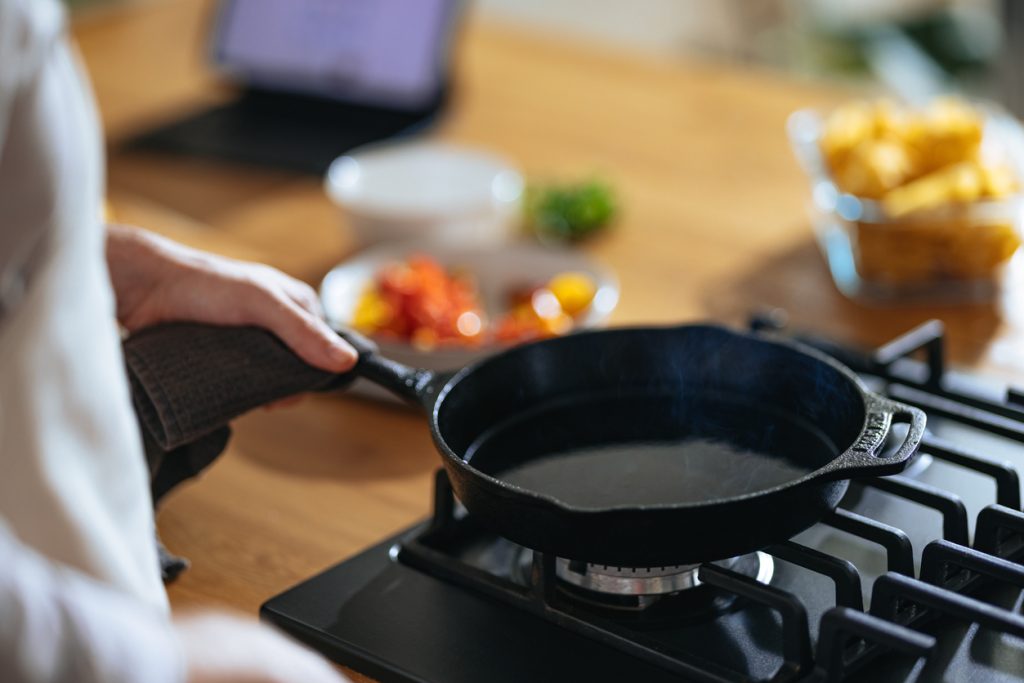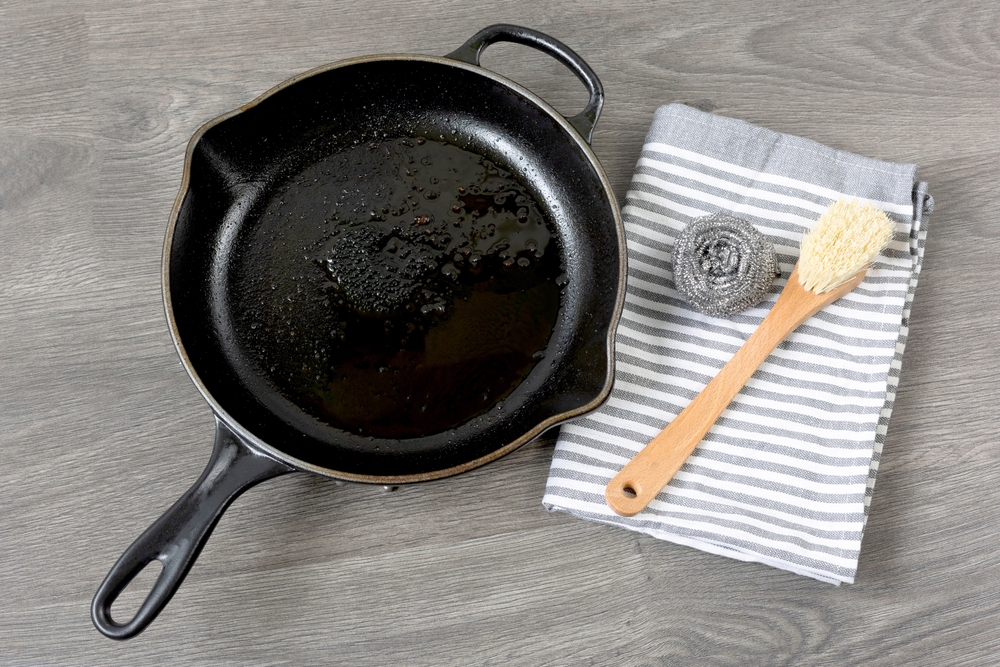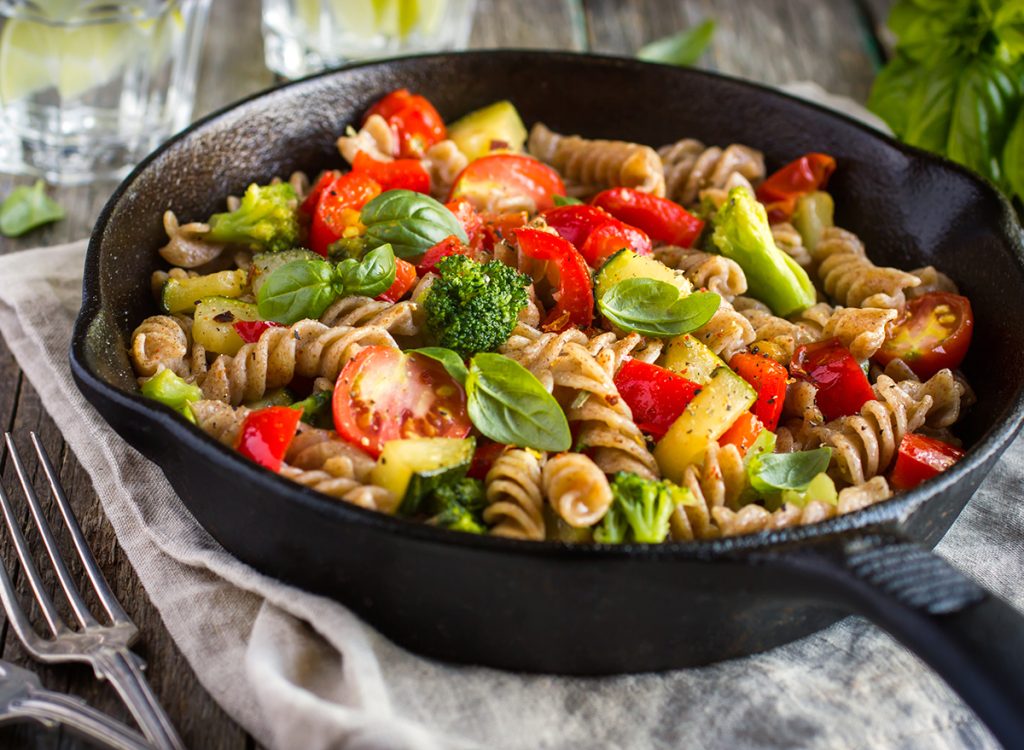How to Season a Cast Iron Skillet, According to Cooking Experts

Given the amount of tools and gadgets available, it may seem impossible to have all the essential kitchen items you need on hand without blowing out your budget. But most chefs would agree that a cast iron skillet is one item worth investing in, thanks to how affordable and versatile they are. However, before you can start whipping up meals, it’s important to know how to season a cast iron pan to get the best results. Read on for the best advice from cooking experts on how to get started and keep your utensil up to snuff over time.
RELATED: How to Safely Store Fruit to Keep It Fresh and Tasty.
What Is a Cast Iron Skillet?

The timeless tool has maintained relevance for a good reason: There’s not much a cast iron skillet can’t do.
“Cast iron has been used for generations and is making its way back into popularity,” says Jessica Robinson, two-time cookbook author and founder of A Farmgirl’s Kitchen. “People are cooking and baking at home more regularly and looking for alternatives to nonstick cookware.”
As the name suggests, a cast iron skillet is a cooking pan made from cast iron. And while it might seem old-fashioned, this traditional material comes with plenty of benefits.
“Cast iron skillets are known for their excellent heat retention and even heating,” explains Jessica Chan, former professional chef and current food blogger at Jecca Chantilly. “They’re heavy, durable, and versatile.”
She says that cooks love them because they’re ideal for various cooking methods, including searing, frying, sauteeing, and even baking.
“When seasoned and maintained properly, cast iron skillets even offer nonstick capabilities,” Chan adds.
Why Is It Important to Season a Cast Iron?

Unlike your nonstick pots and pans, cast iron cookware isn’t ready to fire up right out of the box: You’ll need to prepare it first.
“Seasoning is a crucial component of keeping cast iron working properly,” says Robinson. “Regular usage of your skillet or cast iron bakeware over time will leave a thin layer of cooking oil residue that creates a natural nonstick surface. In addition, it also helps cast iron cookware from rusting.”
RELATED: 7 Best Food Processors Chefs Have in Their Own Kitchens.
How to Season a Cast Iron Skillet

Ready to start cooking? Luckily, it won’t take you too long to get everything ready. Here’s how to season a cast iron skillet, according to experts.
Clean the Pan
The first part of the seasoning process should be to wash the unseasoned cast iron skillet by hand with warm water and a few drops of dish soap, says Chan.
“Then, immediately dry the skillet with a paper towel or dishcloth to prevent rusting,” she says.
Coat It With Cooking Oil
Once the skillet is wiped clean, Chan says to rub a thin coating of vegetable oil onto the entire surface, including the cooking surface. You can also opt to use high-quality extra virgin olive oil, flaxseed oil, canola oil, peanut oil, or other cooking oils with a high smoke point.
“Use a paper towel to spread it evenly and wipe away any excess oil,” she suggests.
Place It Upside Down in a Hot Oven
Your next step is to place the pan upside down on the middle rack of an oven that has been preheated to 400 degrees. Chan then says to bake the skillet for at least one hour then turn off the heat and let the pan cool completely in the oven.
“This process binds the oil to the cast iron and forms a protective layer of coating,” Chan explains.
Robinson also suggests taking one extra step to help with clean up, by placing a piece of aluminum foil on the bottom rack of your oven to catch any oil drips.
RELATED: How to Compost: A Step-by-Step Guide.
Cook With It Often
Following the process above—and repeating it, if needed—isn’t the only way to get your iron skillet read or cast iron pans ready.
“The second best way to season cast iron is by simply cooking with it,” says Chan. “Regularly cooking with oil in a cast iron skillet will develop an extra layer of seasoning you can’t get from cooking oil alone.”
How Often Should You Season a Cast Iron?

Seasoning cast iron isn’t something you do once and then forget about, however. You’ll need to repeat the process over time.
“A cast iron skillet should be thoroughly re-seasoned in the oven every three to four months for optimal performance,” Chan says. “But cooking with oil in the cast iron skillet regularly can help maintain the seasoning.”
The re-seasoning process follows the same steps as the initial one, including cleaning and wiping down the pan before covering it in the cooking oil of your choice and sending it through another round in the oven.
How to Clean a Seasoned Cast Iron Skillet

Once you season a cast iron pan, you’ll also need to take special considerations in maintaining it.
“You should clean a cast iron pan by hand with hot water and a sponge,” says Jeff Leitman, CEO of Hell’s Kitchen Cookware. “Food should be scraped off, using coarse salt, a stiff brush, or steel wool to remove stubborn food stains. After each cleaning, it is recommended to apply a light coat of oil to maintain the seasoning on the cast iron skillet.”
Robinson suggests always thoroughly wiping down and drying your clean cast iron pan, or even consider putting it back on the stove over low heat to ensure all water evaporates. However, there is still some debate about whether or not to use traditional dishwashing methods.
“I’ve found that I use soap mostly on the outside of my skillets,” says Robinson. “If you use too much soap on the inside, it can easily remove the seasoning you’ve worked hard to maintain. Cast iron pans are pieces that are meant to last a lifetime and be passed down for generations.”
RELATED: Which Cooking Oil Should You Use, and What Are the Benefits of Each?
What Can You Cook in a Cast Iron?

Most cooks would agree that it’s worth the effort to season a cast iron pan simply because of how much the simple tool can accomplish in the kitchen.
“Since cast iron retains heat well and distributes the heat more evenly, it helps cakes and baked goods rise better and bake more evenly,” says Robinson. “But it’s not only great for baking: It’s perfect for homemade pizza, dinner rolls, bread, cornbread, biscuits, quiche, and more. Plus, cast iron is great on the stovetop, oven, on the grill, or for campfire cooking.”
It’s also the optimal piece of cookware for certain techniques. “Cast iron skillets are great for many recipes since they can withstand high heat,” says Leitman. “Pan-seared foods, such as steaks and vegetables, are especially great.”
Foods to Avoid With a Cast Iron
Though it’s a versatile wonder, not all dishes belong in a cast iron pan.
“Cast iron is a reactive material so it’s important to avoid cooking highly acidic foods like tomatoes and citrus,” says Chan. “The acidity can strip the seasoning and cause the food to taste metallic.”
It’s best to use non-reactive pans like stainless steel when cooking with highly acidic foods, she suggests. However, time can also play a factor.
“I have also found if you bake a pie in cast iron, remove it as soon as it’s completely cooled, or it will remove all of the seasoning,” Robinson warns.
Conclusion
Getting the most out of your cast iron cookware comes down to knowing how to season it properly. The process involves cleaning the new pan and fully drying it before wiping down all surfaces with high-heat cooking oil. Then, place it in a hot oven for an hour before turning off the heat and letting it cool.
As time goes by and you cook with your pan, you’ll need to repeat the process and re-reseason it. Experts say you should also avoid using too much soap on your cookware, instead using steel wool and stiff brushes to remove food scraps before wiping the pan dry and lightly re-seasoning with a little oil on the stovetop.